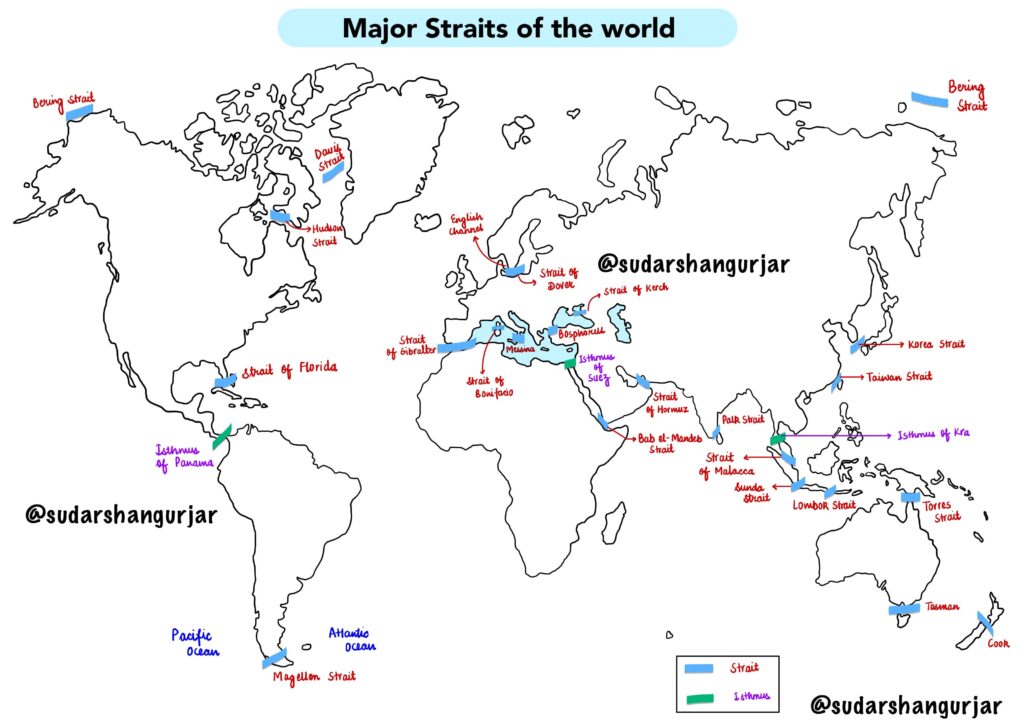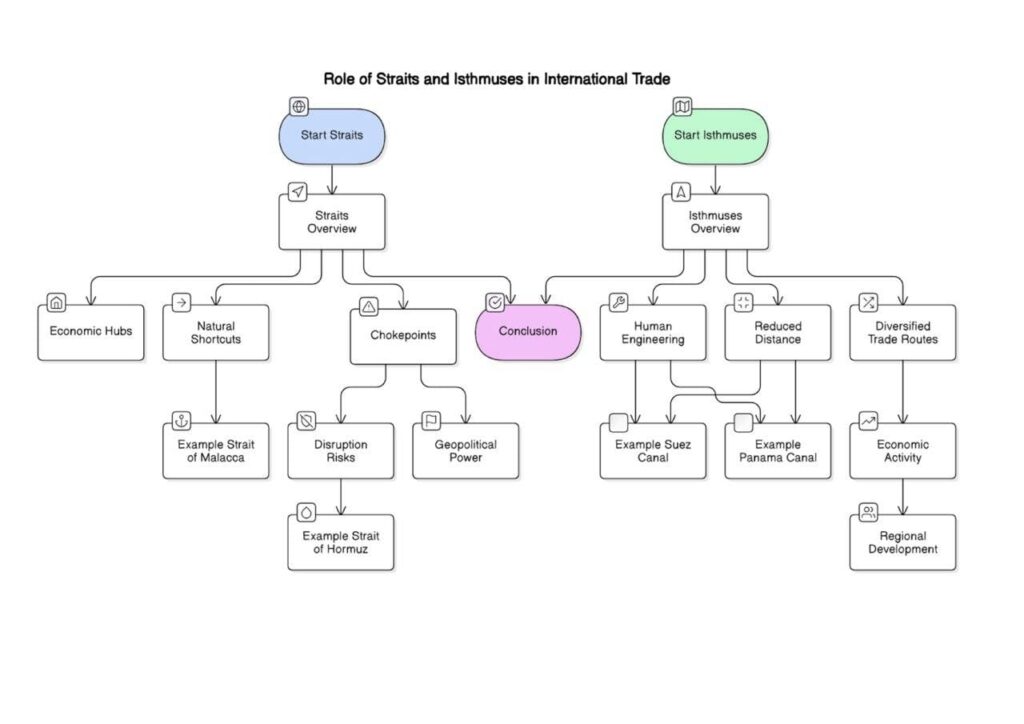Strait : A strait is a water body connecting two seas or water basins.
- Imagine a strait as a narrow, watery path connecting two big lakes or oceans, often with land on either side, like a watery bridge. These aren’t just any waterways; they’re shaped by powerful forces like tides, currents, and sometimes even glaciers.
- Straits come in all shapes and sizes, with different depths and stories of how they came to be. Some formed when water broke through land, like the Bering Strait, while others, like the Strait of Magellan, were carved by glaciers and shifting land.
- You’ll find straits that are short and sweet or long and winding, stretching for hundreds of kilometers. Some are shallow, just a few meters deep, while others plunge over a kilometer down. The water in these channels is always on the move, creating currents that carry sand and sediment, shaping the landscape, and affecting the local wildlife.
- Straits are crucial for maritime navigation, trade, and the movement of marine life. They act as vital ecological corridors, facilitating the exchange of species and nutrients. Formed by a complex interplay of geological and hydrodynamic processes, straits are captivating features of our planet. Consider the Strait of Gibraltar, connecting the Atlantic Ocean and the Mediterranean Sea, or the Strait of Malacca, a key artery between the Indian Ocean and the South China Sea. Each strait is a testament to the power and beauty of natural forces.

Major straits around the world:
- Malacca Strait: This is the longest strait in the world, stretching about 800 km between Indonesia and Malaysia. It’s a vital maritime route connecting the Indian Ocean to the South China Sea, serving as a busy passage for ships traveling between East and West.
- Bab al-Mandab Strait: Located between Yemen and Djibouti, this narrow waterway is only about 29 km wide. It separates the Arabian Peninsula from Africa and is a crucial route for global oil transport, with a significant portion of the world’s oil passing through it.
- Strait of Gibraltar: This famous strait separates Spain and Morocco, linking the Atlantic Ocean with the Mediterranean Sea. It has historically been a strategic gateway between Europe and Africa.
- Palk Strait: Situated between India and Sri Lanka, this shallow strait is less than 100 meters deep and connects the Bay of Bengal with the Gulf of Mannar. It’s known for its biodiversity and the famous Adam’s Bridge, a chain of sandbanks and shoals.
- Strait of Hormuz: Between Iran and Oman, this narrow strait is only about 21 miles long but extremely important for global oil trade, as a large percentage of the world’s petroleum passes through it.
- Bering Strait: This icy passage between Russia and Alaska connects the Arctic Ocean with the Pacific Ocean. It’s about 85 km wide and has played a vital role in migration and exploration.
- Dardanelles Strait: Located in Turkey, it links the Aegean Sea to the Sea of Marmara and is a key route for maritime trade between the Black Sea and the Mediterranean.
- Bosporus Strait: This narrow, winding waterway in Turkey separates Europe from Asia, connecting the Black Sea to the Sea of Marmara, and is one of the busiest waterways in the world.
- Foveaux Strait: Separates the Tasman Sea and the Java Sea. Between New Zealand’s South Island and Stewart Island, it’s famous for its oyster beds and historical significance for whaling.
- Taiwan Strait: Between China and Taiwan, this busy waterway is crucial for trade and passenger transport, connecting the East China Sea with the South China Sea.
- These straits are not only important for navigation and trade but also hold strategic, ecological, and historical significance across the globe.
Previous Year Question UPSC Mains 2022.
Question : Mention the significance of straits and isthmuses in international trade.
Answer : Straits and isthmuses are two important geographical features that play a crucial role in shaping international trade. Straits are narrow waterways that connect two larger bodies of water, while isthmuses are narrow strips of land connecting two larger landmasses. Both act as vital gateways for the movement of goods and have a significant impact on global commerce.
Importance of Isthmuses in International Trade

- Isthmuses, on the other hand, have been transformed by human engineering into vital trade routes. The Panama and Suez Canals, built across the Isthmus of Panama and the Isthmus of Suez, respectively, have revolutionized global shipping.
- These canals drastically reduce the distance ships need to travel—for example, the Panama Canal saves nearly 8,000 nautical miles for ships traveling between the east and west coasts of the Americas.
- By providing these land-based shortcuts, isthmuses help diversify and secure global trade routes, reducing reliance on longer and sometimes riskier sea passages. They also become centers of economic activity, attracting investments, creating jobs, and fostering regional development.
Importance of Straits in International Trade
- Straits serve as natural shortcuts for maritime trade routes, making shipping faster and more cost-effective. For example, the Strait of Malacca connects the Indian Ocean to the South China Sea, providing the shortest sea route between major Asian economies and Europe. Because of this, a huge volume of global trade passes through such straits every day.
- These straits are often called “chokepoints” because any disruption—due to political tensions or piracy—can severely affect international trade and energy supplies. The Strait of Hormuz, for instance, is critical for the transportation of oil from the Middle East to the rest of the world. Control over these straits often translates into geopolitical power, as countries seek to secure their trade interests.
- Moreover, the areas around important straits tend to develop into thriving economic hubs, with major ports and industries benefiting from the constant flow of goods.
In conclusion, straits and isthmuses are more than just geographical features; they are lifelines of international trade. Their strategic locations reduce travel time and costs, enhance economic growth, and influence global geopolitics. Ensuring their security and smooth functioning is essential for maintaining the stability and prosperity of the global trading system.

0 Comments